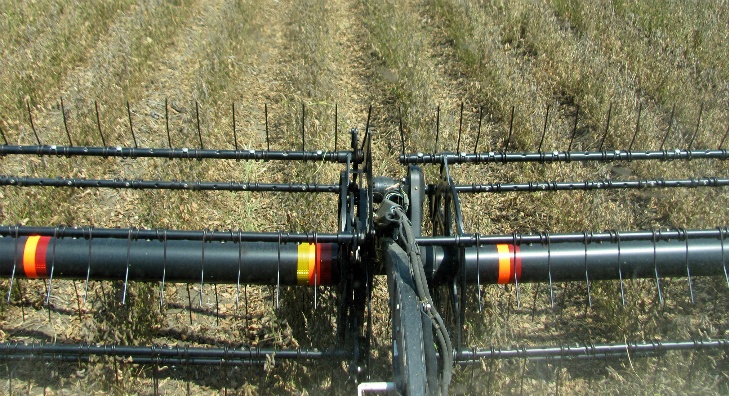Soybean prices free fall as tariff war heats up with China, other countries
by July 10, 2018 5:55 pm 1,406 views

Photo credit: University of Arkansas System Division of Agriculture
Soybean prices have plummeted this year, and the price is approaching a threshold that could make the agri product unprofitable for some farmers, according to University of Arkansas agriculture economist Bob Stark.
Soybeans traded at $8.53 per bushel on Monday, a nearly $1.20 drop from contract prices in mid-November through the end of December 2017, Stark told Talk Business & Politics. If prices drop below $8 per bushel, it’s a psychological and financial barrier that could send soybean producers reeling, but Stark isn’t predicting that to happen.
Prices were as high as $10.50 per bushel this year, but began dropping when President Donald Trump announced billions in tariffs on Chinese goods starting in March, and China announced reciprocal tariffs on many goods including soybeans. This time of year farmers are mostly concerned with the weather, but now many are monitoring the politics of the moment and the markets, Stark said.
“A lot of this volatility is based on concerns and expectations,” he said. “It’s certainly a concern for our growers.”
The trade wars that could result from tariffs against China and other countries are likely to hit the agriculture sector, and especially Arkansas where ag is the dominant sector. Arkansas manufacturers, farmers and consumers will receive a $339 million hit from retaliatory tariffs, with the biggest blow from $225 million in Arkansas goods targeted by Canada in response to the Trump’s administration announcement in June that will impose tariffs on steel and aluminum exports from Canada, Mexico and the EU, according to the U.S. Chamber of Commerce.
ARKANSAS’ TOP CROP
Soybeans are Arkansas’s top crop, and its the second most exported crop from the U.S., according to the U.S. Department of Agriculture’s National Agriculture Statistics Service (NASS). Arkansas soybean farmers harvested 3.5 million acres in 2017, and the crop has a value of $1.74 billion, according to NASS. Farmers had yields of 51 bushels per acre, NASS reported.
At Monday’s bushel price, an Arkansas farmer would have to have a yield of at least 37 bushels per acre to break even with his input costs, and that doesn’t include costs associated with buying or leasing the farm land, Stark said. Producers have had yields far above that in recent years, meaning there is a cushion, but it’s getting thinner, Stark added.
It costs the average soybean farmer an average about $415.11 per acre in input and operating costs to plant and harvest a field. The price drop from the winter to now would have cost farmers about $60 per acre. For every 1,000 acres planted, that’s a $60,000 loss. Most farmers have contracts for their beans that are locked in at different times of he year, meaning the whole crop isn’t necessarily sold at the same price, Stark said.
The trade war with China is at the center of the soybean market volatility, Stark said. China imports about 100 million metric tons of soybeans each year, and the U.S. contributes about 35% of that total, according to USDA. Chinese buyers have not been buying American soybeans at the same rate this year, and producers are leery to ship them for fear the shipment may not be accepted when it reaches China, Stark said.
BUYING FROM BRAZIL
Chinese buyers have been trying to buy more soybeans from South American countries such as Brazil. China bought 1.1 million metric tons of soybeans last week from China, and none from the U.S., according to AgWeb. Chinese companies typically start booking U.S. soybeans this time of year, but have not, AgWeb reported. South American soybean prices will increase as the Chinese try to buy more, Stark said. It wouldn’t surprise him if the Chinese stockpile South American soybeans before turning to U.S. producers to fill their needs later in the year.
There could be other opportunities for U.S. producers as China buys up South American soybeans, Stark said. Those beans would have been sold to some other country, meaning those countries could turn to the U.S. to meet those needs, he said. Another problem with South American soybeans is transportation. The U.S. has established transportation routes with China, and to redirect this amount of soybeans will be a logistical challenge, Stark said.
The U.S. has threatened trade wars with Canada, Mexico, and the European Union, meaning those other potential markets also could be compromised, Stark said. The USDA will release an updated soybean crop on July 12 and it could provide insight as to federal government expectations for the export market, Stark said.
Another factor may be depressing soybean prices. During the last decade, the market has risen to its highest levels in history and part of what is happening now could be part of return to historical norms for international soybean trade, Stark said. Worldwide soybean consumption might be on the decline, but until the tariff questions are answered it will be hard to assess, he added.
“We could see more declines (in price) based on expectations. … Uncertainty will continue until the political problems are solved. The market is very sensitive right now,” Stark said.
